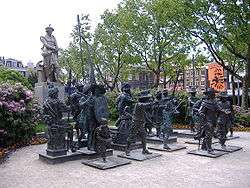Rembrandtplein
Rembrandtplein (Rembrandt Square) is a major square in central Amsterdam, Netherlands, named after Rembrandt van Rijn who owned a house nearby from 1639 to 1656.
History
The square has its origins in the defensive walls constructed in the Middle Ages to protect the city. The site of Rembrandtplein held a Regulierspoort or gateway into the city. By 1655, the city had expanded beyond this area and it began to attract visiting farmers who brought their butter, dairy and poultry products to sell in the city and it became known as Botermarkt or butter market. By 1668, the Regulierspoort housed a Waaggebouw or weigh house. Each autumn, the square hosted a fair and the farmers' stalls were replaced by dance orchestras and circus tents. The market continued under this name until 1876 when a statue of Rembrandt by sculptor Louis Royer was moved from the perimeter to the centre of the square and it was renamed Rembrandtplein (eng.: Rembrandt Square).[1][2]
By the early twentieth century, the square developed into a centre for nightlife drawing artists, young people and laborers. To serve these visitors, several hotels, cafés and entertainment venues opened in the adjoining streets. The area continues to be popular with residents and tourists.[3]
Adjacent area
The square is bordered on the east by Utrechtsestraat, Reguliersdwarsstraat on the south, Regulierbreestraat on the north and Halvemaansbrug on the west. The largest building on the square, across Utrechtsestraat, was designed in 1926 by architects Bert Johan Ouëndag and Hendrik Petrus Berlage as the head office of the Amsterdamsche Bank, later ABN AMRO.[4] ABN AMRO vacated the structure in 2002 and in 2011 it reopened as retail office building named simply The Bank with 25,000 m2 (270,000 sq ft) of space after a five-year renovation.[5]
Thorbeckeplein, named after politician Johan Rudolf Thorbecke (1798–1872), is adjacent to the south, and leads to Herengracht.
Tram lines 4, 9 and 14 operate on Regulierbreestraat and connect Rembrandtplein to the Stopera, northwest across the Blauwbrug (Blue Bridge) on the Amstel River, Dam Square to the northeast, and Amsterdam Centraal railway station.
Design
In December 2006, the square became home to a large interactive LCD-screen. The display measures 7.6 m × 15 m (25 ft × 49 ft) and, in addition to programmed advertisements, allows passers-by to upload videos with a Bluetooth enabled mobile phone.[6] At the time of installation, the screen was the largest in Europe at 114 m2 (1,230 sq ft).[7]
The statue of Rembrandt was made in 1852 by sculptor Louis Royer and is of cast iron. It was cast in one piece and it is Amsterdam's oldest surviving statue in a public space. The current design of the square is the result of a €3.5 million renovation completed in December 2009. The statue is on a grey granite base bearing a replica of his signature. It occupies a space in the centre of the square facing a plaza paved with matching gray granite slabs accented by planters, trees and a small fountain. The perimeter of the square is bordered by grass and trees.[8]
The Night Watch

As part of the celebration of the artist's 400th birthday in 2006, a bronze-cast representation of his most famous painting, The Night Watch, by Russian artists Mikhail Dronov and Alexander Taratynov was displayed around the Royer work. This bronze-cast representation[9] of the famous painting was on display for three-years before traveling to New York City, Moscow and Oranienbaum, Russia. In 2012, the bronze Night Watch sculptures returned to the redesigned square where they serve as a magnet for visitors. In January 2013, the Rembrandtplein Entrepreneurs Foundation began a fundraiser to keep the sculptures in the square throughout the year.[10]
References
- "History". rembrandtplein.com. Retrieved 2013-02-19.
- "Rembrandt's Amsterdam". Rembrandt House Museum. Retrieved 2013-02-20.
- "Rembrandtplein". Project for Public Spaces. Archived from the original on 2014-05-12. Retrieved 2013-02-19.
- "This building is an icon". thebankamsterdam.nl. Archived from the original on 2012-01-22. Retrieved 2013-02-21.
- "Official opening of The Bank in Amsterdam". Iamsterdam.com. 8 March 2012. Archived from the original on 19 October 2013. Retrieved 2013-02-21.
- "Biggest outdoor interactive video screen on Rembrandtplein". Simply Amsterdam. 14 December 2006. Retrieved 2013-02-21.
- "Europe's largest LED advertising screen". DutchAmsterdam.com. 13 August 2009. Retrieved 2013-02-21.
- "Rembrandtplein to get a new look". DutchAmsterdam.com. 27 January 2009. Retrieved 2013-02-21.
- Nightwatch3d.com
- "The Nightwatch must remain". rembrandtplein.com. 9 January 2013. Retrieved 2013-02-19.
External links
| Wikimedia Commons has media related to Rembrandtplein, Amsterdam. |